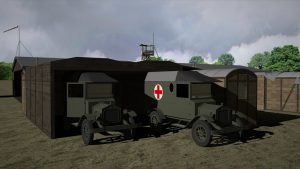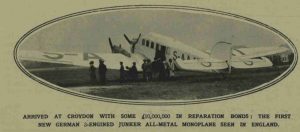The merging of the RFC and the RNAS to form the Royal Air Force (RAF) raised fears about losing their specialised female workforce. The WRAF was formed on 1st April 1918 to create a separate women’s air service. Their work was divided into clerks and store women, household, technical and non technical. They were not trained at first and recruited according to their existing skills.
Despite this, the minimum age for joining was 18 with a strict selection process, including stringent health checks which eliminated poor women who lived in polluted cities. Lengthy enrolment forms were enforced, which, as well as the usual application questions, asked for many statements of agreement to conditions, such as the right to be fined for breaching any rules of their contract.
 |
Women working on bi-plane wings at Waring and
Gillow’s factory in Lancaster (BL23741/034)
Historic England |
As a result educated, upper class women were recruited as officers while the rest became members. They also fell into two categories: ‘immobiles’ who were attached to their local station and lived at home, and ‘mobiles’ who lived in quarters near their workplace allowing them to be transferred in necessary.
The WRAF also held strict behaviour standards. A booklet laid out their rules and constitution, including a ban on smoking both on duty and in public, their uniform requirements and complaints procedure. This led to their reputation as the most disciplined and professional of all the women’s services.
When the former members of the WAAC and WRNS were given the choice of transferring, over 9,000 joined and civilian enrolment increased their numbers. They were first dispatched to RAF bases in Britain and then to France and Germany in 1919. By April 1920 the WRAF had disbanded (much to the reluctance of the RAF); in just two years 32,000 WRAFs had become an advantage to the RAF, paving the way for all future air service women. All three women’s services were reformed just before the outbreak of World War II.
Over six million men enlisted to go and fight overseas so their jobs in Britain had to be fulfilled by women, who still took on traditional roles such as nurses and factory workers, which could be dangerous work. Many women were keen to help with the war effort and they were able to use traditional household organisational skills to help other people undertake war work. They also helped with fundraising, planting vegetables and knitting clothes for soldiers, from the earliest days of conflict.
 |
| NAF Sports Waddon Fuselage No 1 team |
The first female police officers also served during WW1 but they were mainly women’s patrols designed to maintain discipline and monitor women’s behaviour around factories and hostels. Women also worked on transport as bus conductors, ticket collectors, porters, cleaners and even bus drivers. The increase in women’s employment meant that childcare was needed and the rise in single women rose. On the positive side, women’s football teams were created to encourage women to exercise. Even the way they dressed changed.
As a result the scale of women’s employment could no longer be hidden or denied; but the war did not increase women’s wages. From one skilled role employers were able to create several less skilled roles that women could be employed at at a lower wage and not be ‘replacing’ a man directly.
Women at home played an enormous role in the War Effort (known as the Home Front);with approximately 1.6 million entering the workforce during the war. By Armistice Day 950,000 worked in munitions factories like the one in Croydon, called National Aircraft Factory No. 1; but were made redundant when the war ended in November 1918. The Factory dismissed around 1,500 employees on Saturday January 11th 1919, while the remaining 600 took a pay cut. The Factory was located opposite Beddington Aerodrome. The Factory employed 2,500 to 3000 staff (half of what was needed) and half of this workforce was female. They were responsible for not only stitching the canvas that made up the plane wings but also operated machine tools and were involved in aircraft assembly,
Women also worked in textile factories which also made uniforms. Images which featured women undertaking industrial, war related work help reinforce the message that they were making valuable contributions to the war effort.
There has always been a lot of focus on women’s roles during the World Wars, but their roles were seen as temporary and always as in support of men’s roles. It was assumed that that once the war was over they would go back to their regular roles as wives and mothers. However some women relished the chance to not only have a job outside of the home, but also to experience jobs and careers that previously only men could do.
Written by Tania Rahman, Visitor Services Assistant at the British Museum (and volunteer for Fighting for Air)






